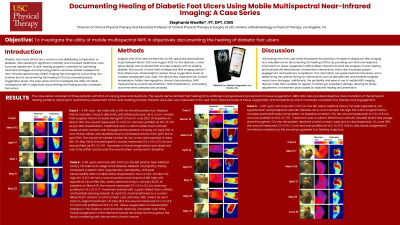Case Series/Study
(CS-156) Documenting Healing of Diabetic Foot Ulcers Using Mobile Multispectral Near-Infrared Spectroscopy: A Case Series

Diabetic foot ulcers (DFUs) are a common and debilitating complication of diabetes, often leading to significant morbidity and increased healthcare costs. Accurate assessment of ulcer healing progress is essential for optimizing treatment strategies and improving patient outcomes. Mobile multispectral near-infrared spectroscopy (NIRS) has emerged as a promising non-invasive tool for documenting the healing of DFUs by evaluating tissue oxygenation levels. This case series aims to investigate the utility of mobile multispectral NIRS in objectively documenting the healing process of diabetic foot ulcers.
Methods: Subjects with DFUs were enrolled into an IRB-approved observational study. For this abstract, a case series design was employed that includes subjects that underwent evaluation using multispectral NIRS. A hand-held multispectral NIRS imaging device* that utilizes near-infrared light to assess tissue oxygenation levels at multiple wavelengths was used. Patient demographics, clinical characteristics, NIRS measurements, wound characteristics, and healing outcomes were collected and analyzed.
*MIMOSA Pro; MIMOSA Diagnostics, Inc., Toronto, ON.
Results: The case series consisted of four patients with DFUs of varying sizes and durations. The results demonstrated that healing DFUs exhibited a progressive improvement in tissue oxygenation. NIRS data also provided objective documentation of the temporal healing patterns, allowing for quantitative assessment of the ulcer healing process.
Discussion:
The findings from this case series emphasize the potential of mobile multispectral NIRS as a valuable tool for documenting the healing of DFUs. By providing real-time and objective information on tissue oxygenation, NIRS enables clinicians to track the progress of ulcer healing and evaluate the effectiveness of treatment interventions. This information can guide treatment decisions, aid in determining the optimal timing for interventions such as debridement or revascularization, and facilitate targeted wound care strategies. Additionally, the portability and ease of use of mobile NIRS devices make them suitable for regular monitoring in outpatient settings, allowing for timely adjustments to treatment plans based on objective healing documentation.
Trademarked Items:
References:

.png)
